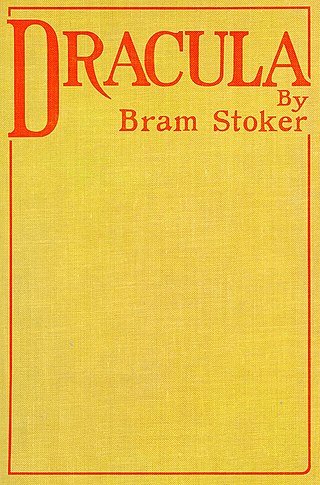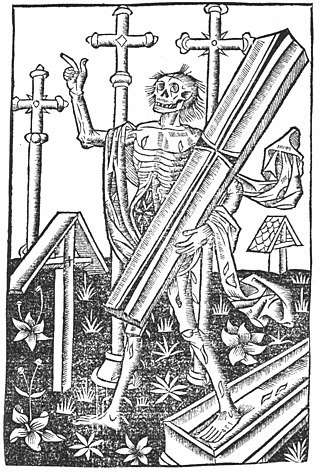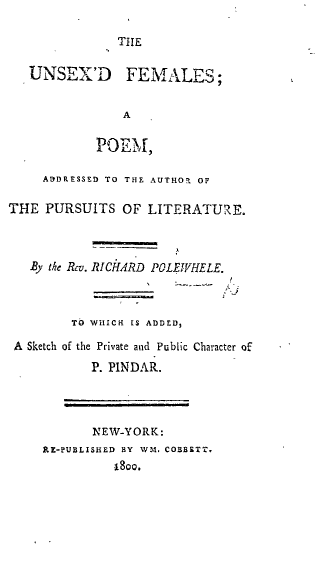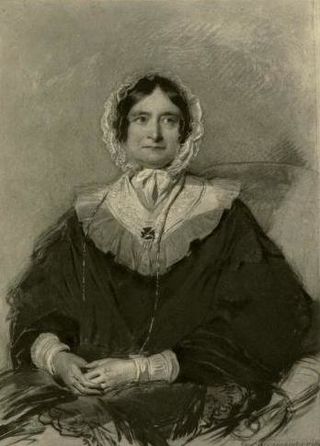
Dracula is a novel by Bram Stoker, published in 1897. An epistolary novel, the narrative is related through letters, diary entries, and newspaper articles. It has no single protagonist and opens with solicitor Jonathan Harker taking a business trip to stay at the castle of a Transylvanian nobleman, Count Dracula. Harker escapes the castle after discovering that Dracula is a vampire, and the Count moves to England and plagues the seaside town of Whitby. A small group, led by Abraham Van Helsing, investigate, hunt and kill Dracula.

Gothic fiction, sometimes called Gothic horror, is a loose literary aesthetic of fear and haunting. The name refers to Gothic architecture of the European Middle Ages, which was characteristic of the settings of early Gothic novels.

A vampire is a mythical creature that subsists by feeding on the vital essence of the living. In European folklore, vampires are undead creatures that often visited loved ones and caused mischief or deaths in the neighbourhoods which they inhabited while they were alive. They wore shrouds and were often described as bloated and of ruddy or dark countenance, markedly different from today's gaunt, pale vampire which dates from the early 19th century. Vampiric entities have been recorded in cultures around the world; the term vampire was popularized in Western Europe after reports of an 18th-century mass hysteria of a pre-existing folk belief in Southeastern and Eastern Europe that in some cases resulted in corpses being staked and people being accused of vampirism. Local variants in Southeastern Europe were also known by different names, such as shtriga in Albania, vrykolakas in Greece and strigoi in Romania, cognate to Italian 'Strega', meaning Witch.

Aphra Behn was an English playwright, poet, prose writer and translator from the Restoration era. As one of the first English women to earn her living by her writing, she broke cultural barriers and served as a literary role model for later generations of women authors. Rising from obscurity, she came to the notice of Charles II, who employed her as a spy in Antwerp. Upon her return to London and a probable brief stay in debtors' prison, she began writing for the stage. She belonged to a coterie of poets and famous libertines such as John Wilmot, Lord Rochester. Behn wrote under the pastoral pseudonym Astrea. During the turbulent political times of the Exclusion Crisis, she wrote an epilogue and prologue that brought her legal trouble; she thereafter devoted most of her writing to prose genres and translations. A staunch supporter of the Stuart line, Behn declined an invitation from Bishop Burnet to write a welcoming poem to the new king William III. She died shortly after.

Anna Seward was an English Romantic poet, often called the Swan of Lichfield. She benefited from her father's progressive views on female education.

William Henry Fitton was an Irish physician and amateur geologist.

In folklore, a revenant is a spirit or animated corpse that is believed to have been revived from death to haunt the living. The word revenant is derived from the Old French word revenant'returning'.

The Unsex'd Females, a Poem (1798), by Richard Polwhele, is a polemical intervention into the public debates over the role of women at the end of the 18th century. The poem is primarily concerned with what Polwhele characterizes as the encroachment of radical French political and philosophical ideas into British society, particularly those associated with the Enlightenment. These subjects come together, for Polwhele, in the revolutionary figure of Mary Wollstonecraft.

The Botanic Garden (1791) is a set of two poems, The Economy of Vegetation and The Loves of the Plants, by the British poet and naturalist Erasmus Darwin. The Economy of Vegetation celebrates technological innovation and scientific discovery and offers theories concerning contemporary scientific questions, such as the history of the cosmos. The more popular Loves of the Plants promotes, revises and illustrates Linnaeus's classification scheme for plants.

George Sebastian Rousseau is an American cultural historian resident in the United Kingdom.

"Fragment of Novel" is an unfinished 1819 vampire horror story written by Lord Byron. The story, also known as "A Fragment" and "The Burial: A Fragment", was one of the first in English to feature a vampire theme. The main character was Augustus Darvell. John William Polidori based his novella The Vampyre (1819), originally attributed in print to Lord Byron, on the Byron fragment. The vampire in the Polidori story, Lord Ruthven, was modelled on Byron himself. The story was the result of the meeting that Byron had in the summer of 1816 with Percy Bysshe Shelley where a "ghost writing" contest was proposed. This contest was also what led to the creation of Frankenstein according to Percy Bysshe Shelley's 1818 Preface to the novel. The story is important in the development and evolution of the vampire story in English literature as one of the first to feature the modern vampire as able to function in society in disguise. The short story first appeared under the title "A Fragment" in the 1819 collection Mazeppa: A Poem, published by John Murray in London.

The history of botany examines the human effort to understand life on Earth by tracing the historical development of the discipline of botany—that part of natural science dealing with organisms traditionally treated as plants.
The Lord Ruthven Award is an annual award presented by the Lord Ruthven Assembly, a group of academic scholars specialising in vampire literature and affiliated with the International Association for the Fantastic in the Arts (IAFA).
Maria Elizabetha Jacson was an eighteenth-century English writer, as was her sister, Frances Jacson (1754–1842), known for her books on botany at a time when there were significant obstacles to women's authorship. In some sources her name appears as Maria Jackson, Mary Jackson or Mary Elizabeth Jackson. She spent most of her life in Cheshire and Derbyshire, where she lived with her sister following her father's death.
The known works of Anna Seward include the following:

Sarah Fitton was an Irish writer and botanist. Assisted by her sister Elizabeth, Sarah Fitton wrote Conversations on Botany (1817), framed as a series of conversations between a mother and her son on botany and the principles of Linnaean taxonomy. The book focuses on the identification and use of plants in a domestic setting, and influenced the popularity of botany as a field of scientific study for women. Color engravings differ between editions of the book.
Lady Charlotte Murray was a Scottish botanist and author. She was the eldest child of John Murray, 3rd Duke of Atholl, and Charlotte Murray, Duchess of Atholl. Her paternal grandfather was the Jacobite general Lord George Murray while her maternal grandfather was the Hanoverian James Murray, 2nd Duke of Atholl.

Sarah Hoare (1777–1856) was a British author and artist known for her scientific poetry.

Kirsten Saxton is a professor of English at Mills College in Oakland, California where she is also the director of the MA of English.
John Proctor Anderdon (1760–1846) was an English merchant, banker and slave-owner, known also as an art collector. He was elected a Fellow of the Royal Society in 1811.















